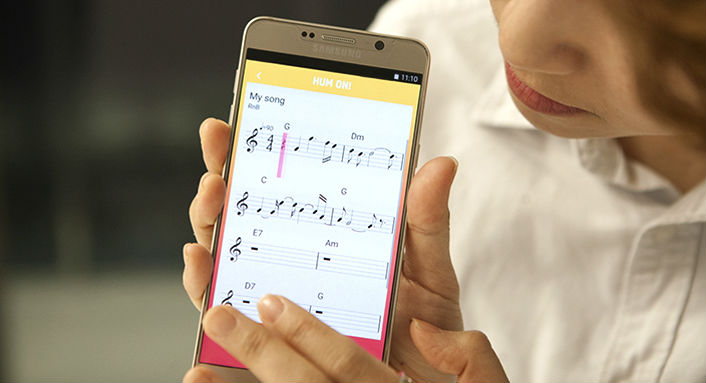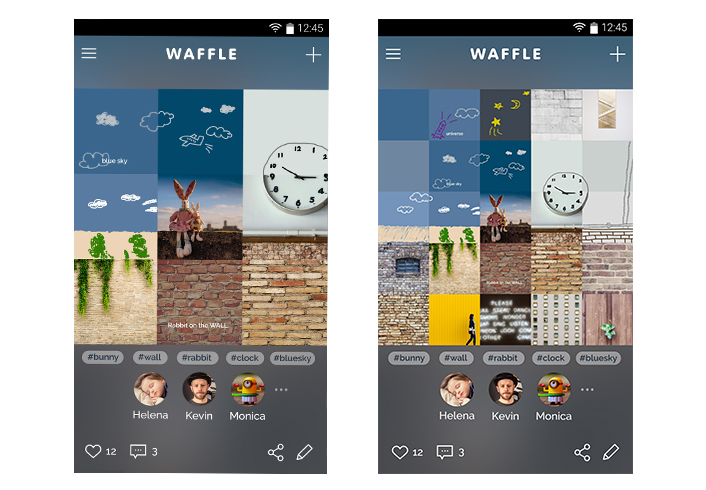Samsung to Unveil Hum On!, Waffle and Entrim 4D Experimental C-Lab Projects at SXSW 2016
on March 14, 2016
At this year’s South by Southwest, Samsung Electronics will showcase for the first time a trio of secret projects from C-Lab—an innovation program that helps its employees to nurture their own creative business ideas.
These projects include Hum On!, an app that transcribes hummed melodies into musical scores; Waffle, a social media platform that enables collaborative content creation; and Entrim 4D, a VR accessory that lets users feel the movements of the on-screen action. As the projects are still in the development stage, they are being showcased to assess their market potential and to gather feedback from attendees at Austin’s annual tech and music festival.
You can get hands-on with all three of these C-Lab projects at South by Southwest from March 13 to March 16, 2016. The projects will be showcased at Stand 1710 in Exhibit Hall 2 of the Austin Convention Center in Austin, Texas.
Hum On!: A Mobile App That Easily Turns Your Hums into Symphonies
Hum On! is an app that allows just about everyone—from industry veterans to the less tonally-aware—to score, arrange and share hummed melodies in mere minutes.
Think of it as a musical translator of sorts. The app records hummed melodies, instantly transcribes them into musical notation, and then plays it back to you using your preferred arrangement style: R&B, classical or rock.
You can then share your own unique songs via social media, or use them as background music in videos without having to worry about copyright infringement.
The app utilizes analysis software to detect the pitch and duration of a user’s voice, and machine learning to create a suitable accompaniment in the same way a musician considers melody and chords. Compared to similar existing programs, Hum On! is incredibly simple and user-friendly—two characteristics that make the app accessible to all.
“For hundreds of years, music has only been created by a select few, but that will no longer be the case,” explains David Choi, Creative Leader of the project. “With Hum On!, we aim to provide a platform where anyone can turn their inspiration into great music.”
The team is currently focused on improving the recognition accuracy of the app, and is even considering collaborating with musicians to provide more diverse, artist-inspired accompaniments in the future.
Waffle: A Social Media Platform That Enables Collaborative Content Creation
At any given moment, thousands upon thousands of people can be found plugged in and online, thumbs scrolling through social media feeds, eyes glued to seemingly unrelated photos and videos posted by their friends.
Yet, despite the diversity of current platforms, many share a common limitation. Namely, they only allow users to individually publish content.
Waffle, a new content-sharing application, hopes to change that. Boasting a user interface that resembles the grids on a waffle (hence the name), the app enables users to create a new feed of expandable content. They can also add to existing related content, as if contributing to a communal graffiti wall.
For example, a travel enthusiast might start a feed with a photograph taken on her latest trip to Tokyo. Then, others might add, say, a digital doodle of a sumo wrestler, a quote about traveling or an image of some beautifully plated sushi. In this way, Waffle offers a new, differentiated service that illustrates multiple points of view to generate a collaborative story.
“Waffle enables users to add their own perspective to someone else’s content, and vice versa,” says Joseph Kim, Creative Leader of the project. “These doodles, images and messages converge into entirely new content.”
Entrim 4D: A Motion Headset That Lets You Feel (and Not Just See) VR
With a virtual reality headset, the possibilities of what you can see are practically infinite. What you can physically feel, on the other hand, is far more limited, meaning experiences can be fairly restricted in terms of immersion.
But what if VR could trick the part of the ear that regulates your balance and motion into making you feel like you are a part of the excitement?
This is the idea behind Entrim 4D. Using a combination of algorithms and Galvanic Vestibular Stimulation (GVS), a safe and simple technique that sends specific electric messages to a nerve in the ear, the VR accessory synchronizes your body with changing movements in video content.
Electrical signals—like the ones used to help restore balance in stroke patients—are delivered via headphones equipped with electrodes that correspond with movement data input by engineers.
Users thus feel as if they are a part of the on-screen action, and can also sense direction and speed of movement. And, when paired with the team’s Drone FPV, which utilizes data from the drone’s motion sensors, they can even feel like they are flying.
In this regard, Entrim 4D aims to create an unrivaled entertainment experience, removing the need for expensive 4D motion chairs.
“Virtual reality shouldn’t be experienced only with the eyes,” says Steve Jung, Creative Leader of the project. “With Entrim 4D, we hope that people can experience VR the way it was meant to be—with their whole bodies.”
To ensure the best possible VR experience, the Entrim 4D team, made up of an eclectic mix of hardware professionals, software engineers and biomedical engineering experts, have conducted experiments on more than 1,500 people and developed 30 different movement patterns.
They are also working on a version that uses additional electrodes to create a sense of rotational motion.
But the team behind Entrim 4D also hopes that the device will help fix one of the major pain points of virtual reality: motion sickness.
Unsurprisingly, the mental discrepancy of seeing yourself riding a roller coaster or zooming around a race track but not actually experiencing the movement can leave you nauseous, dizzy and can even cause headaches. Entrim 4D, though still in a developmental phase, may well be able to present a new and practical solution.






